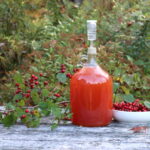Hawthorn Wine
Hawthorn wine is a delectable drink perfect for sipping on warm summer evenings. Made from the berries of the hawthorn tree, this wine harbors a pleasing pink to red hue and ages well.
Servings: 20 glasses, Makes 1 gallon (about 4 bottles)
Equipment
Ingredients
- 4 lbs hawthorn berries
- 2-½ lbs sugar
- Water to fill
- 1 tsp yeast nutrient
- 1 medium Lemon Juiced
- 2 medium Oranges Juiced
- 1 tsp Pectic Enzyme Optional, helps clarify the wine, but not strictly necessary
- wine yeast see note
- Campden Tablet and Potassium Sorbate for Stabilizing Optional, I do not use these
Instructions
- In a wide-mouth carboy, combine all ingredients except yeast.
- Pour boiling water over ingredients and stir to incorporate.
- Let mixture cool.
- Once cool, add yeast. (For dry yeast, be sure to rehydrate first in a small amount of room temperature water for 5 to 10 minutes.) Your wine should begin to bubble now.
- Top with enough water to allow 2 to 3 inches of headspace in your carboy, cover with a wide-mouth water lock and let the mixture ferment for 10 to 14 days.
- After the primary ferment is complete, siphon the mixture into a new fermentation vessel, leaving the fruit and sediment behind.
- Ferment in secondary for 2 months.
- After secondary fermentation is complete, taste the wine and adjust as necessary (see notes). If more sugar is added, allow to ferment another 1 to 2 weeks before bottling.
- Bottle wine by siphoning it into clean bottles and sealing with corks.
- Let the hawthorn wine age for at least 2 weeks before drinking. Aging for 2 months or longer is preferable. Fruit wines will mellow with time and improve in flavor.
Notes
Amount of Fruit
Four pounds of hawthorn berries is the recommended amount for making 1 gallon of hawthorn wine. However, if your berries are sparse, you can use a little less.Yeast
For hawthorn wine, choose a wine yeast with moderate alcohol tolerance that either ferments clean or adds some light fruit flavor. Good yeast choices include Lalvin D47, Lalvin QA23, and Red Star Premier Cuvee or Lalvin EC-1118.Acid Source
In place of lemon and orange juice, you can use 1 tsp of Acid Blend for a cleaner flavor.Stabilizing and Back Sweetening
If your wine tastes too dry at the end of secondary, you can backsweeten it. To backsweeten, move the wine to a clean container (so you don’t stir up any sediment) and add 1 Campden tablet and ½ teaspoon potassium sorbate to stabilize the wine. (If the wine isn’t stabilized before adding sugar, the wine will rapidly ferment and bottles may burst.) Once the wine is stabilized, add sugar to your taste. This should be done by making a simple syrup by dissolving equal parts sugar and water in a saucepan and adding to the wine before bottling. For a general amount, I’d suggest starting with ½ cup sugar per gallon of hawthorn wine. See notes within the article regarding stabilizing and back sweetening.Nutrition
Calories: 273kcal | Carbohydrates: 71g | Protein: 0.4g | Fat: 0.4g | Saturated Fat: 0.03g | Polyunsaturated Fat: 0.1g | Monounsaturated Fat: 0.01g | Sodium: 2mg | Potassium: 129mg | Fiber: 3g | Sugar: 67g | Vitamin A: 80IU | Vitamin C: 14mg | Calcium: 13mg | Iron: 0.2mg
